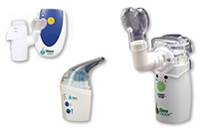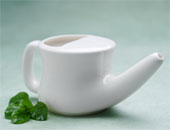December 31st, 2011 by ChristopherChangMD in Opinion, Research
1 Comment »

 I came across this article the other day regarding use of the daVinci robot to perform base of tongue surgery for obstructive sleep apnea.
I came across this article the other day regarding use of the daVinci robot to perform base of tongue surgery for obstructive sleep apnea.
For those who don’t know, the daVinci robot system made by Intuitive Surgical is a robotic system whereby the surgeon directs the arms of the robot to perform surgery in difficult-to-access areas of the body.
My feeling is that using a robot to perform sleep apnea surgery is way overkill akin to using a $50,000 sniper rifle to kill an ant on the wall.
Everything the daVinci robot can do can also be done without the robot with equivalent patient outcomes. In fact, Read more »
*This blog post was originally published at Fauquier ENT Blog*
December 10th, 2011 by ChristopherChangMD in Medblogger Shout Outs, Research
3 Comments »

An interesting blog article from the folks at Compete came to my attention recently. Compete for those who don’t know is a fantastic analytics site to see how ANY website is doing in terms of popularity (number of visitors in a given time period). The basic data is free. For more in depth information, there’s a charge.
For example, for our practice’s website, here is the Compete data I pulled which is pretty accurate based on my own analytics information:

My nearest local competitor in terms of website popularity is the hospital, Fauquier Health System: Read more »
*This blog post was originally published at Fauquier ENT Blog*
August 28th, 2011 by ChristopherChangMD in Research
No Comments »

 The basic function of the human nose is to warm and humidify the air before it reaches the lungs. Because of the wide variation of human habitats from the polar cold and dry air to the equatorial hot and humid weather, one would expect the nose to accommodate to these climate extremes accordingly through evolutionary pressures.
The basic function of the human nose is to warm and humidify the air before it reaches the lungs. Because of the wide variation of human habitats from the polar cold and dry air to the equatorial hot and humid weather, one would expect the nose to accommodate to these climate extremes accordingly through evolutionary pressures.
In essence, logically one would expect the nose to change shape to enhance time that air is in contact with the warm and moist nasal interior in cold and dry climates compared to the opposite environmental extreme.
German scientists evaluated this hypothesis through Read more »
*This blog post was originally published at Fauquier ENT Blog*
July 25th, 2011 by ChristopherChangMD in Research, Video
No Comments »

Many people are already aware of nebulizer treatments to help with breathing during asthma attacks and other pulmonary conditions.
What many people may not be aware of is that such nebulizer treatments can also potentially be used for chronic sinus infections. One of the best known companies offering such treatment is Sinus Dynamics.
 Using one of several different nebulizers, compounded liquid medications (antibiotics and/or steroids) selected by the physician are nebulized/atomized which the patient then breathes into the nasal passages. The small size of the particles allow medication to theoretically move through the tiniest of sinus openings directly onto the infected tissue. Treatments are quick generally lasting 3 – 5 minutes (depending on medication and device). Here’s a video demonstrating how it is used.
Using one of several different nebulizers, compounded liquid medications (antibiotics and/or steroids) selected by the physician are nebulized/atomized which the patient then breathes into the nasal passages. The small size of the particles allow medication to theoretically move through the tiniest of sinus openings directly onto the infected tissue. Treatments are quick generally lasting 3 – 5 minutes (depending on medication and device). Here’s a video demonstrating how it is used.
Sinus Dynamics™ specifically is contracted by over 14,000 insurance companies across the nation, which means that most patients are able to receive their treatment for little to no cost out of pocket.
Most ENT doctors are already familiar with this product.
Personally, I prescribe Read more »
*This blog post was originally published at Fauquier ENT Blog*
July 6th, 2011 by Paul Auerbach, M.D. in Health Tips
No Comments »

 Nasal irrigation is sometimes recommended to thin or remove mucous from the nose. The two most common conditions that produce mucous are upper respiratory infections (e.g., the “common cold”) and allergies. Irrigation may also be beneficial to clear out dust, dirt, and allergens, and to allow the cilia within the nose to function more efficiently. Cilia are organelles that work to move mucous and debris in the nose (among other parts of the body) to a location where they can be expelled more easily. Another benefit of nasal irrigation is that it moisturizes the mucous membranes inside the nose.
Nasal irrigation is sometimes recommended to thin or remove mucous from the nose. The two most common conditions that produce mucous are upper respiratory infections (e.g., the “common cold”) and allergies. Irrigation may also be beneficial to clear out dust, dirt, and allergens, and to allow the cilia within the nose to function more efficiently. Cilia are organelles that work to move mucous and debris in the nose (among other parts of the body) to a location where they can be expelled more easily. Another benefit of nasal irrigation is that it moisturizes the mucous membranes inside the nose.
Methods of Nasal Irrigation
Irrigation can be pulsatile or non-pulsatile (sometimes called “laminar flow”). Each type has its advocates. It is generally felt to be a safe practice so long as Read more »
This post, Everything You Wanted To Know About Nasal Irrigation, was originally published on
Healthine.com by Paul Auerbach, M.D..
 I came across this article the other day regarding use of the daVinci robot to perform base of tongue surgery for obstructive sleep apnea.
I came across this article the other day regarding use of the daVinci robot to perform base of tongue surgery for obstructive sleep apnea.



 The basic function of the human nose is to warm and humidify the air before it reaches the lungs. Because of the wide variation of human habitats from the polar cold and dry air to the equatorial hot and humid weather, one would expect the nose to accommodate to these climate extremes accordingly through evolutionary pressures.
The basic function of the human nose is to warm and humidify the air before it reaches the lungs. Because of the wide variation of human habitats from the polar cold and dry air to the equatorial hot and humid weather, one would expect the nose to accommodate to these climate extremes accordingly through evolutionary pressures. Using one of several different nebulizers, compounded liquid medications (antibiotics and/or steroids) selected by the physician are nebulized/atomized which the patient then breathes into the nasal passages. The small size of the particles allow medication to theoretically move through the tiniest of sinus openings directly onto the infected tissue. Treatments are quick generally lasting 3 – 5 minutes (depending on medication and device). Here’s a
Using one of several different nebulizers, compounded liquid medications (antibiotics and/or steroids) selected by the physician are nebulized/atomized which the patient then breathes into the nasal passages. The small size of the particles allow medication to theoretically move through the tiniest of sinus openings directly onto the infected tissue. Treatments are quick generally lasting 3 – 5 minutes (depending on medication and device). Here’s a 
 Nasal irrigation is sometimes recommended to thin or remove mucous from the nose. The two most common conditions that produce mucous are upper respiratory infections (e.g., the “common cold”) and allergies. Irrigation may also be beneficial to clear out dust, dirt, and allergens, and to allow the cilia within the nose to function more efficiently. Cilia are organelles that work to move mucous and debris in the nose (among other parts of the body) to a location where they can be expelled more easily. Another benefit of nasal irrigation is that it moisturizes the mucous membranes inside the nose.
Nasal irrigation is sometimes recommended to thin or remove mucous from the nose. The two most common conditions that produce mucous are upper respiratory infections (e.g., the “common cold”) and allergies. Irrigation may also be beneficial to clear out dust, dirt, and allergens, and to allow the cilia within the nose to function more efficiently. Cilia are organelles that work to move mucous and debris in the nose (among other parts of the body) to a location where they can be expelled more easily. Another benefit of nasal irrigation is that it moisturizes the mucous membranes inside the nose.







